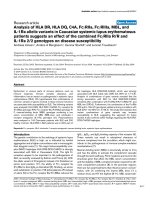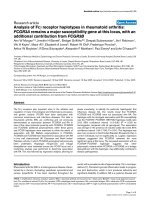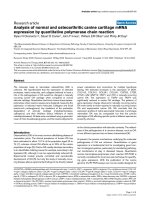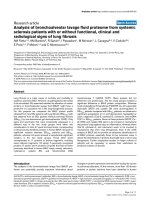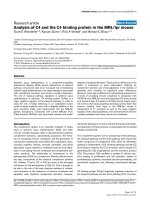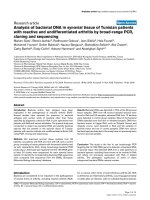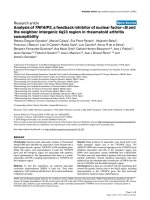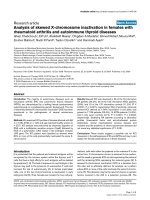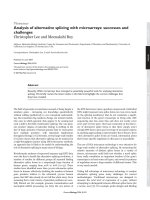Báo cáo y học: "Analysis of immunoglobulin light chain rearrangements in the salivary gland and blood of a patient with Sjögren’s syndrome" pptx
Bạn đang xem bản rút gọn của tài liệu. Xem và tải ngay bản đầy đủ của tài liệu tại đây (907.2 KB, 12 trang )
Introduction
Sjögren’s syndrome (SS) is a chronic inflammatory
disease preferentially involving the lacrimal and salivary
glands. Patients with SS are characterized by keratocon-
junctivitis sicca and xerostomia. Although the cause of
the disease is unknown, histopathologic findings
suggest an essential role of lymphocytic infiltrates that
accumulate in the affected glands. Exogenous antigens
and autoantigens have been suggested as potential trig-
gers of the immune response in the salivary glands in
genetically and hormonally susceptible individuals [1,2].
Whereas glandular tissue destruction has been shown to
be mediated by activated CD4
+
T cells that home into
the lacrimal gland [3], autoantibodies directed against
Ro(SS-A) and La(SS-B) autoantigens as well as IgG
(rheumatoid factor) are detectable in high titers in about
80–95% of sera from SS patients. This suggests an
important role for autoantibodies in this disease [4].
Moreover, a 44-fold increased risk for the development
of lymphoid malignancy, almost exclusive of B-cell origin,
has been documented in SS, emphasizing the intimate
role of activated proliferating B cells in this condition [5].
Whether B-cell activation is a primary cause or a sec-
ondary effect in SS is not known.
CDR = complementary determining regions; FACS = fluorescence-activated cell sorting; FR = framework regions; H & E, hematoxylin and eosin;
PBS = phosphate-buffered saline; PCR = polymerase chain reaction; RF = rheumatoid factor; R/S ratio = replacement to silent ratio; SS =
Sjögren’s syndrome; Th = T helper cells; Vκ = variable kappa chain gene; Vλ = variable lambda chain gene.
Available online />Research article
Analysis of immunoglobulin light chain rearrangements in the
salivary gland and blood of a patient with Sjögren’s syndrome
Annett M Jacobi
1
, Arne Hansen
2
, Olaf Kaufmann
3
, Axel Pruss
4
, Gerd R Burmester
1
,
Peter E Lipsky
5
and Thomas Dörner
1
1
Department of Internal Medicine/Rheumatology and Clinical Immunology, Charite University Hospital, Berlin, Germany
2
Outpatients’ Department, Charite University Hospital, Berlin, Germany
3
Institute of Pathology, Charite University Hospital, Berlin, Germany
4
Institute of Transfusion Medicine, Charite University Hospital, Berlin, Germany
5
NIAMS, National Institutes of Health, Bethesda, Maryland, USA
Corresponding author: Thomas Dörner (e-mail: )
Received: 19 February 2002 Revisions received: 7 May 2002 Accepted: 13 May 2002 Published: 11 June 2002
Arthritis Res 2002, 4:R4
© 2002 Jacobi et al., licensee BioMed Central Ltd (Print ISSN 1465-9905; Online ISSN 1465-9913)
Abstract
Patients with Sjögren’s syndrome (SS) have characteristic
lymphocytic infiltrates of the salivary glands. To determine
whether the B cells accumulating in the salivary glands of SS
patients represent a distinct population and to delineate their
potential immunopathologic impact, individual B cells obtained
from the parotid gland and from the peripheral blood were
analyzed for immunglobulin light chain gene rearrangements by
PCR amplification of genomic DNA. The productive
immunglobulin light chain repertoire in the parotid gland of the
SS patient was found to be restricted, showing a preferential
usage of particular variable lambda chain genes (Vλ2E) and
variable kappa chain genes (VκA27). Moreover, clonally related
V
L
chain rearrangements were identified; namely, VκA27–Jκ5
and VκA19–Jκ2 in the parotid gland, and Vλ1C–Jλ3 in the
parotid gland and the peripheral blood. Vκ and Vλ
rearrangements from the parotid gland exhibited a significantly
elevated mutational frequency compared with those from the
peripheral blood (P < 0.001). Mutational analysis revealed a
pattern of somatic hypermutation similar to that found in normal
donors, and a comparable impact of selection of mutated
rearrangements in both the peripheral blood and the parotid
gland. These data indicate that there is biased usage of V
L
chain genes caused by selection and clonal expansion of
B cells expressing particular V
L
genes. In addition, the data
document an accumulation of B cells bearing mutated V
L
gene
rearrangements within the parotid gland of the SS patient.
These results suggest a role of antigen-activated and selected
B cells in the local autoimmune process in SS.
Keywords: B cells, parotid gland, Sjögren’s syndrome, somatic mutation, V light chain genes
Page 1 of 12
(page number not for citation purposes)
Page 2 of 12
(page number not for citation purposes)
Arthritis Research Vol 4 No 4 Jacobi et al.
Structures resembling germinal centers have been
detected in the salivary glands of patients with SS [3,6],
but it is not known whether the microenvironment of these
cell clusters is sufficient for the induction of a germinal
center response. Of note, however, recent studies have
reported that B cells obtained from the salivary glands or
lymph nodes of patients with SS have mutated V gene
rearrangements, suggesting an antigen-driven local
immune response [6,7].
To examine the nature of the local B-cell responses in SS
in more detail, the present study compared a population of
individual B cells obtained from the parotid gland and
peripheral blood B cells in a patient with SS by analyzing
nonproductive and productive light chain gene rearrange-
ments amplified by PCR from genomic DNA. As a result, a
number of differences became apparent between parotid
gland B cells and peripheral blood B cells of this patient.
In the parotid gland, the productive light chain repertoire
was found to be restricted, showing a preferential usage
of particular Vλ and Vκ genes, some of which were clon-
ally related. Moreover, productive V
L
rearrangements
showed a significantly higher mutational frequency com-
pared with the patient’s peripheral blood, with an
increased number of silent mutations in the complemen-
tary determining regions (CDR) and framework regions
(FR) resulting in a somewhat decreased replacement to
silent (R/S) ratio in the V
L
gene repertoire of parotid gland
B cells. Of note, Vλ rearrangements showed a significantly
higher mutational frequency, but no significant difference
in R/S ratio compared with Vκ rearrangements. These
findings indicate that the B cells in the parotid gland of SS
patients represent a unique population that may result
from a local antigen-driven immune response.
Materials and methods
Patient’s material
Peripheral blood B cells and B cells obtained from the
parotid gland of a patient fulfilling the revised criteria for
classification of SS [8] were analyzed. The patient was a
76-year-old female who manifested a typical histology of
the minor salivary glands (focus score >1). The duration
of the disease was 9 years at the time of analysis. The
patient expressed elevated titers of anti-52 kDa Ro(SS-A)
and anti-52 kDa La(SS-B) antibodies, had marked hyper-
gammaglobulinemia, and was rheumatoid factor (RF) pos-
itive. The patient did not have extraglandular organ
manifestations besides leukopenia (3.6 × 10
9
/µl), and
she was taking 400 mg hydroxychloroquine and 2 mg
prednisone daily at the time of analysis. After developing
parotid gland enlargement, lymphoma of the parotid
gland was excluded by partial parotidectomy and histo-
logical examination. After approval by the local ethics
committee and informed consent from the patient were
obtained, peripheral blood and parotid tissue were further
processed for B-cell analysis.
Preparation of peripheral blood mononuclear cells
FACS sorting of individual B cells and the method of PCR
amplification of V
L
chain gene rearrangements have been
reported in detail recently [9–11]. In the present study,
188 individual peripheral CD19
+
B cells were analyzed.
Preparation of mononuclear cells from the parotid gland
To obtain a cell suspension from the parotid gland, fresh
tissue samples (about 1–2 cm
3
) were washed immedi-
ately in heparinized medium (RPMI 1640; Biochrom KG,
Berlin, Germany), minced with scissors, and subse-
quently pressed in a tissue hand-homogenizer (NeoLab,
Heidelberg, Germany). Following suspension (1: 4; v/v) in
PBS (pH 7.4), the homogenate was sequentially sieved
through nylon cell strainers with 100 and 40 µm mesh
(Falcon; Becton Dickinson, Franklin Lakes, NJ, USA),
removing soft tissue fragments. For separation of
mononuclear cells, the cell suspension was centrifuged
over a ficoll hypaque gradient, and washed in PBS. Stain-
ing with monoclonal anti-CD19 antibodies and FACS
sorting of individual B cells were carried out as previously
described for peripheral blood B cells [9–11]. A total of
188 individual CD19
+
B cells obtained from the parotid
gland were analyzed.
Controls
Immunoglobulin V
L
chain rearrangements from the periph-
eral blood of two healthy normal donors (26 and 45 years
old) analyzed previously [10,11] were used for compari-
son. Both the nonproductive and productive repertoires of
these donors exhibited a comparable usage of Vκ and Jκ
as well as Vλ and Jλ gene elements [10,11].
Determination of Taq polymerase fidelity and the
frequency of potential sequence errors
The PCR error rate for this analysis has been documented
to be approximately 1 × 10
–4
mutations/base [12]. Few if
any of the nucleotide changes encountered in this analysis
can thus be ascribed to amplification errors.
Analysis of sequences
Sequences were analyzed using the V BASE Sequence
Directory [13] to identify the underlying germline gene.
Statistical analysis
Nonproductive as well as productive V
L
chain rearrange-
ments of peripheral blood B cells of the patient were com-
pared with those of B cells obtained from the parotid
gland. We further compared nonproductive as well as pro-
ductive light chain rearrangements of peripheral blood B
cells from the patient and those of normal controls.
Sequences were analyzed with Fisher’s exact test to
compare the differences in the distribution of particular V
L
gene segments, whereas mutational frequencies and R/S
ratios were compared using the chi-square-test. P ≤ 0.05
was considered statistically significant.
Page 3 of 12
(page number not for citation purposes)
Mutations within each codon were analyzed and
expressed as the percentage of individual codons with
replacement or silent mutations. Mutational ‘hot spots’
were identified in the nonproductive and productive reper-
toires by determining the mean number of mutations of
each codon, and by identifying codons that contained
mutations greater than the mean ± 1.96 standard devia-
tions (95% confidence interval) [14].
Accession numbers
Sequences have been submitted to the EMBL database:
Vκ gene rearrangements from peripheral blood B cells,
accession numbers AJ 426144–AJ 426222; Vκ gene
rearrangements from parotid gland B cells, accession
numbers AJ 426223–AJ 426297; Vλ gene rearrange-
ments from peripheral blood B cells, accession numbers
AJ 426298–AJ 426378; and Vλ gene rearrangements
from parotid gland B cells, accession numbers AJ
426379–AJ 426416.
Results
In the present study, 75 VκJκ gene rearrangements (23
nonproductive and 52 productive) and 38 VλJλ rearrange-
ments (nine nonproductive and 29 productive) were ampli-
fied and sequenced from individual B cells obtained from
the parotid gland. They were compared with 79 VκJκ gene
rearrangements (40 nonproductive and 39 productive) and
81 VλJλ rearrangements (27 nonproductive and 54 produc-
tive) obtained from the peripheral blood of the same patient.
V
L
and J
L
gene usage
V
λ
gene usage
Analysis of the usage of individual Vλ genes in the produc-
tive Vλ gene repertoires revealed a significantly higher fre-
quency of the Vλ2E segment in the parotid gland
compared with the peripheral blood of the SS patient
(21% versus 4%, P < 0.05). Furthermore, the Vλ7A gene
was over-represented in the patient’s peripheral blood
compared with the frequency found in normal controls
Available online />Figure 1
Distribution of individual Vλ genes in B cells from the peripheral blood and from the parotid gland of a patient with Sjögren’s syndrome (SS)
compared with those of normal healthy subjects (NHS). The Vλ gene usage of normal donors is published elsewhere [11]. Vλ genes are arranged
starting with the genes located within the A-cluster of the Vλ locus (J-proximal). The significant differences in the frequency of occurrence of 3H
•
(P < 0.05)/7A
§
(P < 0.05)/1G* (P < 0.005)/10A° (P < 0.005) gene rearrangements comparing the nonproductive and productive Vλ gene
repertoire suggest processes of positive and negative selection of these Vλ gene segments.
(15% versus 2%, P < 0.005) (Fig. 1). Clonality of neither
Vλ2E nor Vλ7A was detected. Rearrangements using the
Vλ1C gene were frequently found in the parotid gland
(17%) and in the patient’s peripheral blood (11%), but this
gene was not significantly over-represented in peripheral
blood B cells of the patient compared with normal donors.
Four Vλ1C–Jλ3 rearrangements (two in the peripheral
blood and two in the parotid gland) appeared to be
related. They showed an almost identical Vλ–Jλ joining
region as well as CDR3 composition with three nucleotide
changes in the parotid gland rearrangements which were
probably related to the process of somatic hypermutation
(Fig. 2).
V
κ
gene usage
Analysis of individual Vκ genes in the nonproductive reper-
toire revealed a higher usage of the Vκ gene segment A27
in the parotid gland (10%) versus that in the patient’s
peripheral blood (0%) (P < 0.05). Moreover, the Vκ gene
B2 was found significantly more frequently in the gland
(24%) than in the peripheral nonproductive repertoire
(3%) (P < 0.005).
Further analysis of the distribution of individual Vκ genes in
the productive Vκ gene repertoire revealed a significantly
higher frequency of the gene A27 in the parotid gland of
the patient (29%) compared with that in the peripheral
blood (8%, P < 0.05) (Fig. 3). In the parotid gland, two out
of 15 rearrangements using A27 were clonally related (see
later). A second Vκ rearrangement employed A19 with
three mutations, shared the same CDR3 and, therefore,
appeared to be clonally related (see later).
J
L
gene usage
In contrast to the observed differences in the V
L
gene
usage, J
L
genes were used comparably in the parotid
gland and the peripheral blood.
A predominant Jκ2 usage was found in the nonproductive
repertoire (65%) as well as the productive repertoire
(59%) of peripheral blood B cells from the SS patient and
the parotid gland (70 and 65%, respectively) as compared
to all remaining Jκ gene families in the nonproductive (Jκ1,
4%; Jκ3, 0%; Jκ4, 0%; Jκ5, 26%) and productive (Jκ1,
10%; Jκ3, 4%; Jκ4, 2%; Jκ5, 19%) repertoires of the
parotid gland and the nonproductive (Jκ1, 5%; Jκ3, 0%;
Jκ4, 8%; Jκ5, 23%) and productive (Jκ1, 18%; Jκ3, 8%;
Jκ4, 0%; Jκ5, 15%) repertoires of peripheral blood B cells
of the patient.
Furthermore, Jλ2/3 genes were used predominantly in the
productive and nonproductive repertoires of the peripheral
blood (85 and 89%, respectively), and exclusively in non-
productive rearrangements and in 80% of the productive
rearrangements of the parotid gland. Other Jλ gene fami-
lies were used rarely by nonproductive rearrangements of
the peripheral blood (Jλ1, 7%; Jλ7, 4%) but not by non-
productive rearrangements of the gland and by productive
rearrangements of the peripheral blood (Jλ1, 0%; Jλ7,
7%) and the parotid gland (Jλ1, 0%; Jλ7, 7%).
Clonally related V
L
gene rearrangements
Two out of 15 VκA27 rearrangements obtained from the
parotid gland B cells were rearranged to Jκ5 and showed
sequence homology. The rearrangements had a CDR3 of
seven amino acids and a total of 16 mutations with a R/S
ratio of 12:1 (four replacement mutations in CDR1, three
replacement mutations in CDR2, one replacement muta-
tion in CDR3, two replacement mutations in FR2, and two
replacement mutations and one silent mutation in FR3).
Two clonally related rearrangements from the parotid
gland B cells employed VκA19 and Jκ2, had a CDR3 of
nine amino acids, and shared three replacement mutations
(one in CDR1, and two in FR2 each). Finally, two
rearrangements from the parotid gland and two from
peripheral blood employed Vλ1C–Jλ3, and they shared an
almost identical CDR3 (11 amino acids) (Fig. 2). However,
the rearrangements from the blood were unmutated
whereas the rearrangements from the parotid gland B
cells had 18 and seven mutations, respectively, which
were corresponding only in part. One of these rearrange-
ments had a R/S ratio of 11/4 (3/0 mutations in FR1, 3/1
mutations in FR2, 1/2 mutations in FR3, 1/1 mutations in
CDR1, 2/0 mutations in CDR2, and 1/0 mutations in
Arthritis Research Vol 4 No 4 Jacobi et al.
Page 4 of 12
(page number not for citation purposes)
Figure 2
Vλ1c–Jλ3b rearrangements obtained from the peripheral blood
(D10IVL1F9 and D10IIVL1E12) and from the parotid gland
(PaIVL1E11 and PaIVL1G12) of the patient with Sjögren’s syndrome.
CDR3), with 8/16 (50%) mutations in RGYW/WRCY
motifs. The other rearrangement had a R/S ratio of 6/0
(one replacement mutation in CDR1, three replacement
mutations in CDR2, and two replacement mutations in
FR2), with 2/7 (28.5%) in RGYW/WRCY quartet
sequences, respectively. In contrast, no preferential V
L
gene usage was found in normal healthy subjects.
Mutational analysis
Frequency of mutated V
L
gene rearrangements
V
λ
gene rearrangements. The frequency of mutated non-
productive Vλ genes was very similar in the SS patient
(peripheral blood and parotid gland) and in normal con-
trols (49–55%) (Table 1).
Productive Vλ gene rearrangements obtained from the
patient’s parotid gland were mutated at a higher frequency
(83%) compared with those of the patient’s peripheral
blood B cells (56%). Peripheral blood B cells of the SS
patient and of normal controls (58%), however, were
mutated at a comparable rate.
V
κ
gene rearrangements. The frequency of mutated non-
productive Vκ genes was somewhat lower in parotid
gland B cells from the patient compared with the periph-
eral blood (17% versus 38%, respectively), but was com-
parably high in peripheral blood B cells of the patient with
SS (38%) and normal healthy donors (24%) (Table 2).
The frequency of mutated nonproductive Vκ genes (17%)
was lower in the gland than the frequency of mutated non-
productive Vλ genes (55%). As in Vλ gene rearrange-
ments, a greater frequency of productive Vκ gene
rearrangements from parotid gland B cells was mutated
(86%) compared with peripheral blood B cells (54%)
(P = 0.002).
Mutational frequency
V
λ
gene rearrangements. The nonproductive Vλ gene
rearrangements (0.76% versus 0.33%, P < 0.01) and the
productive Vλ gene rearrangements (3.32% versus
0.97%, P < 0.001) of parotid gland B cells showed signifi-
cantly greater mutational frequencies than Vλ gene
rearrangements of peripheral blood B cells. Moreover,
nonproductive Vλ genes from the parotid gland exhibited
a significantly lower mutational frequency compared with
productive Vλ gene rearrangements (0.76% versus
3.32%, P < 0.001). As observed in B cells from the
parotid gland, peripheral blood B cells of the patient
Available online />Page 5 of 12
(page number not for citation purposes)
Figure 3
Distribution of individual Vκ genes in B cells from the peripheral blood and from the parotid gland of a patient with Sjögren’s syndrome (SS)
compared with those of peripheral blood B cells from normal healthy subjects (NHS).
#
The significant difference in the frequency of occurrence of
VκB2 comparing the nonproductive and productive Vκ gene repertoire suggests negative selection of this gene segment (P < 0.005). Vκ gene
usage of normal donors has been published elsewhere [10]. Vκ genes are arranged in order from J-proximal to J-distal.
(0.97% versus 0.33%, P < 0.001) and of normal donors
(1.12% versus 0.60%, P < 0.001) also showed a greater
mutational frequency in productively rearranged Vλ genes
compared with nonproductive Vλ gene rearrangements.
Vλ2E was frequently used in productive Vλ gene
rearrangements obtained from the parotid gland of the SS
patient. The mutational frequency of productive Vλ2E
gene rearrangements from parotid gland B cells (3.65%)
was twice as high as that of productive Vλ2E gene
rearrangements from the peripheral blood of the patient
(1.80%, P = 0.052). Similar results were obtained when
comparing the mutational frequency of productive Vλ1C
gene rearrangements from the parotid gland (3.65%) with
that of Vλ1C gene rearrangements from the peripheral
blood (0.27%, P < 0.001).
In contrast to these findings, productive Vλ7A gene
rearrangements found to be over-represented in the
peripheral blood only of the patient exhibited a lower muta-
tional frequency (0.38%) than other productively
rearranged Vλ genes in the peripheral blood (1.06%,
P = 0.005) or in the parotid gland (Vλ7A, 0.74%,
P = 0.385; remaining Vλ gene rearrangements, 3.42%,
P < 0.001) of the patient with SS.
V
κ
gene rearrangements. Productive Vκ gene rearrange-
ments from the parotid gland of the patient exhibited a
significantly greater mutational frequency than productive
Vκ gene rearrangements from the peripheral blood
(2.35% versus 0.77%, P < 0.001). A significantly lower
mutational frequency of productive Vκ gene rearrange-
ments of peripheral blood B cells (0.77%) was identified
in the patient with SS compared with normal healthy
donors (1.08%, P = 0.005). In contrast, nonproductive
Vκ gene rearrangements of parotid gland B cells were
mutated at a similar frequency as those from the patient’s
peripheral blood. Notably, in the productive repertoire of
parotid gland B cells, there was a significantly greater
mutational frequency in Vλ rearrangements than in Vκ
rearrangements (3.32% versus 2.35%, P < 0.001). In
contrast, Vλ and Vκ gene rearrangements from the
peripheral blood B cells exhibited a comparable muta-
tional frequency.
Arthritis Research Vol 4 No 4 Jacobi et al.
Page 6 of 12
(page number not for citation purposes)
Table 1
Mutational frequency of Vλ gene rearrangements of B cells from the peripheral blood and from the parotid gland of a patient with
Sjögren’s syndrome (SS), and of peripheral blood B cells from normal healthy subjects (NHS)
SS peripheral blood SS parotid gland NHS peripheral blood
Vλ Nonproductive Productive P* Nonproductive Productive P* Nonproductive Productive P*
Overall mutational frequency (%) 0.33
†§
0.97
‡
< 0.001 0.76
†
3.32
‡
< 0.001 0.60
§
1.12 < 0.001
Mutated Vλ gene rearrangements (n) 14 30 5 24 27 100
Total Vλ gene rearrangements (n) 27 54 9 29 55 172
% mutated Vλ gene rearrangements 52 56 55 83 49 58
* Significant difference between the mutational frequency found in the nonproductive versus the productive Vλ gene repertoire (χ
2
test).
†
P < 0.01
and
‡
P < 0.001, significant difference between the mutational frequency of the nonproductive and productive, respectively, Vλ gene
rearrangements of B cells from the peripheral blood and the parotid gland of a patient with SS.
§
P < 0.05, significant difference between the
mutational frequency of the nonproductive Vλ gene rearrangements of peripheral blood B cells from the patient with SS and of normal donors.
Table 2
Mutational frequency of Vκ gene rearrangements of B cells from the peripheral blood and from the parotid gland of a patient with
Sjögren’s syndrome (SS), and of peripheral blood B cells from normal healthy subjects (NHS)
SS peripheral blood SS parotid gland NHS
Vκ Nonproductive Productive P* Nonproductive Productive P* Nonproductive Productive P*
Mutational frequency (%) 0.20
§
0.77
†‡
< 0.001 0.09 2.35
†
< 0.001 0.48
§
1.08
‡
< 0.001
Mutated Vκ gene rearrangements (n) 15 21 4 43 55 133
Total Vκ gene rearrangements (n) 40 39 23 50 232 321
% mutated Vκ gene rearrangements 38 54 17 86 24 41
* Significant difference between the mutational frequency found in the nonproductive versus the productive Vκ gene repertoire (χ
2
test).
†
P = 0.005 and
‡
P < 0.001, significant differences in the mutational frequency of the productive Vκ gene rearrangements of B cells from the
peripheral blood compared with the parotid gland of a patient with SS or with normal donors.
§
P < 0.001, significant difference between the
mutational frequency of the nonproductive Vκ gene rearrangements of peripheral blood B cells from the patient with SS and of normal donors.
The mutational frequency of productive rearrangements
using VκA27 from the parotid gland was significantly
higher (3.89%) than that of the remaining productive Vκ
gene rearrangements in the parotid gland (1.85%,
P < 0.001) or that of the VκA27 gene rearrangements
from the patient’s peripheral blood (0.45%, P < 0.001).
Notably, the two clonally related VκA27–Jκ5 rearrange-
ments had a mutational frequency of 7.3% (16/219).
Replacement to silent ratio
Because of the significant differences in the mutational
frequencies of productively rearranged V
L
genes from the
peripheral blood and from the parotid gland of the SS
patient, further analysis addressed the nature of these
mutations. The R/S ratio of the nonproductive Vκ and Vλ
repertoire could not be assessed individually because of
the small number of mutations in the nonproductively
rearranged V
L
genes of the SS patient. The overall R/S
ratios of all nonproductive V
L
gene rearrangements,
however, were 2.9 (29/10) (CDR, 3.3 [13/4]; FR, 2.7
[16/6]) for the peripheral blood B cells and 5.7 (17/3)
(CDR, 7.0 [7/1]; FR, 5 [10/2]) for the parotid gland B
cells. Comparison with the respective R/S ratios of the
nonproductive and productive repertoires revealed only a
significant difference of the ratios in the FR of peripheral
blood B cells (2.7 versus 1.9, P < 0.024).
Despite striking differences in the mutational frequency of
the productive V
L
gene rearrangements from the parotid
gland and the peripheral blood of the patient, there was no
significant difference in the R/S ratios. Comparison of the
R/S ratio in the peripheral blood of the patient and of
normal donors also revealed no major differences
(Tables 3 and 4). No significant difference was again
found when the R/S ratios of the CDR of all V
L
rearrange-
ments (5.4 [98/18] of peripheral blood versus 3.7
[188/51] of the parotid gland) were compared between
the two compartments.
Mutational ‘hot spots’
Further analysis addressed the distribution of the muta-
tions in productively rearranged V
L
genes. A similar pattern
of mutational ‘hot spots’ was noted in parotid gland and
peripheral blood productive rearrangements (Fig. 4)
despite the significantly higher mutational frequency in V
L
gene rearrangements of the parotid gland. ‘Hot spots’ of
replacement mutations were almost exclusively located
within the CDR.
V
λ
gene rearrangements. With regard to replacement
mutations, codon position 39 represented a mutational
‘hot spot’ within FR2 in productive Vλ gene rearrange-
ments obtained from the parotid gland (6/29). In more
detail, four Vλ1C gene rearrangements exhibiting a
replacement mutation at this codon position, causing a
replacement of leucine (CTC) by phenylalanine (TTC),
seemed to be selected positively in the gland. A large
number of silent mutations was observed within the FR2
and FR3 of productive Vλ gene rearrangements of the
parotid gland.
V
κ
gene rearrangements. Mutational ‘hot spots’ of
replacement mutations were located exclusively in the
CDR. Within the FR2 (codon position 45) and FR3
(codon positions 77 and 87) of productive Vκ gene
rearrangements from the parotid gland B cells, an accu-
mulation of silent mutations was observed consistent with
the findings in the productive Vλ gene repertoire of parotid
gland B cells.
Mutations of RGYW and WRCY sequences
To characterize the pattern of somatic hypermutation of
the V
L
gene rearrangements of B cells from the patient’s
peripheral blood and the parotid gland in more detail, the
contribution of mutations within the previously described
highly mutable motif RGYW and its inverse repeat,
WRCY, was determined [14].
V
λ
gene rearrangements. There was no significant differ-
ence in the occurrence of the highly mutable quartets in
the germline (8.1–8.8% of quartets) in the nonproductive
as well as the productive Vλ gene rearrangements of B
cells from the peripheral blood or from the parotid gland of
the SS patient. In the nonproductive repertoire of periph-
eral blood and parotid gland B cells, respectively, 18.2%
(4/22) and 23.5% (4/17) of all mutations were within
RGYW/WRCY motifs. In the productive repertoire,
however, this percentage was significantly increased, with
45.0% (59/131, P = 0.018) and 48.1% (117/243,
P = 0.049), respectively (Table 5), indicating a lack of tar-
geting of highly mutable motifs but considerable selection
of mutations in these motifs.
V
κ
gene rearrangements. As in Vλ gene rearrangements,
there was no significant difference in the occurrence of
the highly mutable quartets in the germline of Vκ gene
rearrangements (7.5–8.9% of quartets). In the nonproduc-
tive repertoire, mutations within RGYW/WRCY accounted
for 50% (10/20) of all mutations in Vκ gene rearrange-
ments of B cells from the peripheral blood. This was signif-
icantly more than expected by chance. In contrast, only
20% (1/5) of the observed mutations in nonproductive Vκ
gene rearrangements from parotid gland B cells were
within these highly mutable motifs.
The contribution of RGYW/WRCY mutations to all muta-
tions in the productive Vκ gene repertoire of peripheral
blood B cells was comparable with that observed in the
corresponding nonproductive repertoire (43.2% [32/74]).
In the productive Vκ gene repertoire of the parotid gland B
cells, however, RGYW/WRCY mutations made up 50.6%
(139/257, P = 0.13) of all mutations (Table 5). Similar as
Available online />Page 7 of 12
(page number not for citation purposes)
observed for the Vλ repertoire, this suggests a positive
selection of these mutations in the parotid gland.
Discussion
The present study has identified a number of differences
between parotid gland B cells of a patient with SS com-
pared with B cells obtained from the peripheral blood of
the same patient. This patient manifested increased titers
of autoantibodies (anti-Ro and anti-La), hypergamma-
globulinemia and enlargement of the parotid glands, and
could therefore be considered to have active disease. The
data provide evidence that B cells that infiltrate the salivary
glands in SS were highly selected. The repertoire differ-
ences were especially noteworthy in the productive and,
therefore, the expressed V
L
gene repertoire, and they sup-
ported the conclusion that the parotid gland B cells were
highly selected. B cells from the parotid gland were a dis-
tinct population exhibiting significantly elevated mutational
frequencies in both productive Vκ and Vλ gene rearrange-
ments, and showing preferential expansion and somatic
Arthritis Research Vol 4 No 4 Jacobi et al.
Page 8 of 12
(page number not for citation purposes)
Table 3
Replacement to silent ratio (R/S ratio) of productive Vλ gene rearrangements of B cells from the peripheral blood and from the
parotid gland of a patient with Sjögren’s syndrome (SS), and of peripheral blood B cells from normal healthy subjects (NHS)
SS peripheral blood SS parotid gland Comparison of R/S ratios, NHS peripheral blood
Vλ productively rearranged genes productively rearranged genes P* productively rearranged genes
FR1 1/2 (0.5) 7/3 (2.3) ns 9/5 (1.8)
CDR1 18/3 (6.0) 33/9 (3.7) ns 55/14 (3.9)
FR2 19/8 (2.4) 34/13 (2.6) ns 51/29 (1.8)
CDR2 22/2(11.0) 26/7 (3.7) ns 48/10 (4.8)
FR3 16/8 (2.0) 29/29 (1.0) ns 66/28 (2.4)
CDR3 18/6 (3.0) 23/6 (3.8) ns 81/22 (3.7)
CDR 58/11 (5.3) 82/22 (3.7) ns 184/46 (4.0)
FR 36/18 (2.0) 70/45 (1.6) ns 126/62 (2.0)
Total Vλ gene 94/29 (3.2) 152/67 (2.3) ns 310/108 (2.9)
Because of the small number of mutations exhibited by nonproductively rearranged Vλ genes of B cells from the parotid gland and from the
peripheral blood, only productive Vλ rearrangements were analyzed. FR, framework regions; CDR, complementary determining regions. * Statistical
difference between the R/S ratio of productively rearranged Vλ genes from the parotid gland versus peripheral blood from a patient with SS (ns,
not significant).
Table 4
Replacement to silent ratio (R/S ratio) of productive Vκ gene rearrangements of B cells from the peripheral blood and from the
parotid gland of a patient with Sjögren’s syndrome (SS), and of peripheral blood B cells from normal healthy subjects (NHS)
SS peripheral blood SS parotid gland Comparison of R/S ratios, NHS peripheral blood
Vκ productively rearranged genes productively rearranged genes P* productively rearranged genes
FR1 0/0 (nd) 2/2 (1.0) nd
CDR1 17/3 (5.7) 52/14 (3.7) ns (4.7)
FR2 5/2 (2.5) 23/15 (1.5) ns (1.3)
CDR2 8/0 (nd) 31/6 (5.2) ns (5.4)
FR3 9/6 (1.5) 30/28 (1.1) ns (1.4)
CDR3 15/4 (3.8) 23/9 (2.55) ns (5.0)
CDR 40/7 (5.7) 106/29 (3.7) ns 345/70 (4.9)
FR 14/8 (1.8) 55/45 (1.2) ns 195/144 (1.4)
Total Vκ gene 54/15 (3.6) 161/74 (2.2) ns 540/214 (2.5)
Because of the small number of mutations exhibited by nonproductively rearranged Vκ genes of B cells from the parotid gland and from the
peripheral blood, only productive Vκ rearrangements were analyzed. FR, framework regions; CDR, complementary determining regions. * Statistical
difference between the R/S ratio of productively rearranged Vκ genes from the parotid gland versus peripheral blood from a patient with SS (nd,
not determined; ns, not significant).
mutation of particular V
L
chain rearrangements
(VκA27–Jκ5, VκA19–Jκ2 and Vλ1C–Jλ2/3) compared
with peripheral blood B cells. Of interest, parotid gland V
L
gene rearrangements showed an increased number of
silent mutations in the productive repertoire with no
increase in the R/S ratio compared with the peripheral
blood, suggesting that replacement mutations may have
been negatively selected from this population. Mutations
within RGYW/WRCY sequences appeared to be posi-
tively selected in V
L
gene rearrangements. Altogether,
these results indicate that parotid gland B cells in SS rep-
resent a unique and highly selected B-cell population.
V
L
gene usage
Strong selective influences were detected in the parotid
gland of the patient, with B cells that rearranged VκA27,
VκA19 and Vλ2E as well as Vλ1C being preferentially
expanded. Since these V
L
genes were not found to be
over-represented in the nonproductive V
L
gene repertoire
of the parotid gland, they appeared to result from positive
selection. Furthermore, there was evidence of clonal
expansion of VκA27–Jκ5 and VκA19–Jκ2 rearrangements
in the patient’s parotid gland only, as well as of Vλ1C–Jλ3
rearrangements in both the peripheral blood and parotid
gland of this patient with SS.
One feature of the present patient was that the κ/λ ratio of
B cells in the patient’s peripheral blood was significantly
lower than that found in normal subjects (0.7 versus 1.8)
[10,11]. When the patient’s serum was enriched, the κ/λ
ratio was found to be 1.77, suggesting that different influ-
ences may effect selection of memory B cells versus
plasma cells. It is also possible that the reduced κ/λ ratio
in the blood represents preferential migration of κ-express-
ing B cells (e.g. VκA27 and VκA19) from the blood into
the parotid gland. Notably, the κ/λ ratio in the parotid
gland was 1.8, consistent with this possibility.
Positive selection of particular V
L
chain genes by foreign
or autoantigens present in the parotid gland appears to
shape the productive V
L
chain repertoire in the inflamed
tissue. A restriction of the V
L
chain repertoire has been
described following vaccination. As an example, antibod-
ies against Haemophilus influenzae B that develop as part
of a Th2 response have been identified to be frequently
encoded by VκA2, VκO8/O18, VκL11, VκA17, and
Available online />Page 9 of 12
(page number not for citation purposes)
Figure 4
Frequency of replacement mutations (black) and silent mutations (white) of each codon of productively rearranged V
L
genes of B cells isolated
from peripheral blood and from the parotid gland of a patient with Sjögren’s syndrome. The frequency of mutation of each codon is calculated as
the percentage of sequences that contain mutations in particular codon positions. Mutational ‘hot spots’ of replacement mutations are shown.
Nonproductive V
L
genes were not analyzed because of the small number of mutations. CDR, complementary determining regions.
Table 5
Contribution of mutations of RGYW/WRCY sequences to all
mutations (%) in V
L
gene rearrangements of B cells from the
peripheral blood and from the parotid gland of a patient with
Sjögren’s syndrome (SS), and of peripheral blood B cells from
normal healthy subjects (NHS)
SS peripheral SS parotid NHS peripheral
blood (%) gland (%) blood (%)
Vλ
Nonproductive 18.2* 23.5
†
38
‡
Productive 45.0* 48.1
†
51.3
‡
Vκ
Nonproductive 50.0 20.0 50.6
Productive 43.2 50.6 63.3
Significant difference of the contribution of mutations of RGYW/WRCY
sequences to all mutations comparing nonproductive and productive Vλ
gene rearrangements: * P = 0.018 (chi-square test), peripheral blood
B cells from the patient with SS;
†
P = 0.049, B cells from the parotid
gland; and
‡
P < 0.0001, B cells from the peripheral blood of NHS [27].
VκA27 [15]. Moreover, Vλ genes of the Vλ2 and Vλ7 fam-
ilies were found in the Hib-antibody encoding V
L
gene
repertoire [15]. In addition, VκA27 and Vλ2C, Vλ2E,
Vλ2A2 or Vλ10A were also shown to encode anti-
Streptococcus pneumoniae antibodies [16]. Interestingly,
VκA27 and Vλ2E that were frequently found in the parotid
gland of this patient, with VκA27 expanded clonally, have
also been shown to encode anti-rabies virus antibodies
[17]. Microbial antigens, including bacterial and viral epi-
topes that could be involved in the pathogenesis of SS
[2], could thus also be involved in the selective processes
shaping the V
L
gene repertoires of B cells accumulating in
the parotid gland of this SS patient.
Also, autoantigens might be involved in the accumulation
of parotid gland B cells in this patient. In this regard,
VκA27 was frequently used by RFs in patients with
rheumatoid arthritis [17]. RF is typically present in sera of
patients with SS [18] and was also detected in the saliva
or in salivary gland biopsies [19] of these patients. In this
regard, Martin et al. described two salivary gland lym-
phomas that developed in SS patients from RF-specific
B cells [20]. Moreover, VκA27 has been reported to be
frequently employed by lymphomas developing in the
gland of SS patients [21]. Despite the presence of clon-
ally expanded B cells expressing VκA27, the current
patient did not develop lymphoma during a follow-up
period of 3 years after the examination. This observation
indicates that additional factors or further persistence of
the chronic B-cell proliferation are essential for the devel-
opment of lymphoma.
Histological studies suggest that inflamed ductal epithelial
cells represent the focus of the inflammatory response in
the salivary glands of patients with SS. There is clear evi-
dence of an inflammatory environment with presentation of
self-antigens characteristic of SS [22] that may permit the
production of autoantibodies. Systemic B-cell activation,
characterized by hyperimmunglobulinemia and the produc-
tion of autoantibodies, however, can precede disease man-
ifestations in SS [22]. This suggests the possibility that
enhanced migration or homing of activated lymphocytes
into the salivary glands from other sites of B-cell activation
may play an important role in disease pathogenesis.
In this context, activated epithelial duct cells have been
shown to secrete specific chemokines, such as SDF-1
(CXCL-12) and BCA-1 (CXCL-13), that are capable of
attracting specific B lymphocytes into the glands [22,23].
H & E staining of the parotid tissue revealed lymphoid folli-
cles as well as diffuse plasma cell infiltration of the organ
(Hansen et al., manuscript submitted). This is inline with
the assumption that plasma and memory B cells accumu-
late in the parotid gland but cannot clarify the origin of
these cells. Whatever the primary aberration in the induc-
tion of the salivary inflammation, one abnormality relates to
the generation of ectopic germinal center-like structures in
the inflamed glands. Abnormal migration of B cells into the
salivary glands could contribute to this process.
J
L
gene usage
In contrast to the skewed V
L
gene repertoire, no differ-
ences in the J
L
gene usage were observed when compar-
ing peripheral blood B cells and parotid gland B cells of
the patient. These data rather suggest that selective
processes are dependent on the rearranged V
L
gene.
Mutations
Mutational analysis supported the conclusion that a distinct
B-cell subpopulation accumulated in the parotid gland. The
mutational frequency and the percentage of mutated light
chain genes were greater in the productive V
L
chain
rearrangements of B cells from the parotid gland compared
with those from peripheral blood, but they accumulated a
large number of silent mutations. Interestingly, productively
rearranged Vλ genes of the parotid gland exhibited a signif-
icantly greater mutational frequency than the Vκ gene
rearrangements. Altogether, in the parotid gland and in the
peripheral blood of the SS patient, nonproductive V
L
chain
rearrangements showed a significantly lower mutational fre-
quency than productive V
L
chain genes, suggesting that
mutations were clearly selected.
A positive selection of mutations was previously identified
in V
L
gene rearrangements of normal subjects [10,11], but
not in that of a patient with systemic lupus erythematosus
[24,25]. In the parotid gland, expanded B cells expressing
VκA27 and Vλ2E as well as clonally expanded V
L
chains
were mutated at a significantly higher frequency compared
with the remainder of the repertoire. This finding suggests
that B cells bearing particular receptors may have under-
gone antigen-triggered somatic hypermutation.
Several groups have previously described germinal
center-like structures in the parotid gland [3,6]. The
parotid gland might therefore be able to act as a sec-
ondary lymphoid organ, facilitating somatic hypermutation
and selection of antigen-specific B cells. Antigen-driven
germinal center reactions might proceed within ectopic
lymphoid follicles in the parotid gland, giving rise to highly
mutated antigen-specific B cells. On the contrary, migra-
tion of highly mutated antigen-specific B cells from the
patient’s blood to the parotid gland could also contribute
to the observed differences in the mutational frequencies.
The analysis of somatic mutations of the V
L
gene
rearrangements of the B cells provided evidence of selec-
tion against replacement mutations. In addition, the
marked increase of RGYW/WRCY mutations in the pro-
ductive B-cell repertoire of the parotid indicates that posi-
tive selection of mutations in these highly targeted motifs
occurred in the salivary gland. Selection thus appears to
Arthritis Research Vol 4 No 4 Jacobi et al.
Page 10 of 12
(page number not for citation purposes)
have diminished some mutations while increasing others.
The analysis of the R/S ratio and the mutational ‘hot spots’
of productive V
L
chain rearrangements of peripheral blood
and parotid gland B cells revealed no major abnormalities
when compared with normal donors. This indicates intact
mechanisms of selection against replacement mutations in
the FRs that might cause structural constrains of the
immunoglobulin molecule. The frequency of silent muta-
tions was found to be increased in the productive light
chain repertoire of B cells from the parotid gland, consis-
tent with a reduced R/S ratio in the CDR and FR.
Overall, replacement mutations were selected against in
the parotid gland. This is in line with the observations of
Gellrich et al. [7], Stott et al. [6] and Miklos et al. [26],
who reported a decrease in the R/S ratio in V
H
gene
rearrangements of B cells obtained from the salivary
glands of SS patients or in B cells from mucosa-associ-
ated lymphoid tissue lymphoma in SS patients. Further-
more, Stott et al. described a decreased R/S ratio in the
CDR of V
H
and V
L
gene rearrangements of B cells
obtained by minor salivary gland biopsies from two
patients with SS [6].
Detailed analyses of the frequency of occurrence and
mutations of the highly mutable motifs RGYW and WRCY
revealed that mutations in nonproductive V
L
rearrange-
ments of B cells from the parotid gland were less targeted
towards RGYW on both DNA strands. These mutations of
RGYW on both DNA strands were, however, selected
positively in V
L
gene rearrangements of B cells from the
parotid gland. Although no firm conclusion can be drawn,
it might be possible that the clear pattern of these tar-
geted mutations is basically generated in the parotid gland
of the patient, with particular retention of selected V
L
rearrangements. Altogether, the influences of selection
appeared to be overall intact in the present SS patient.
Conclusion
A biased V
L
gene usage with an over-representation of
expanded B cells using VκA27, VκA19, and Vλ1C, a posi-
tive selection of mutations (especially within RGYW and
WRCY sequences), and indications of selection against R
mutations in the V
L
gene rearrangements were observed
in B cells from the parotid gland, compared with periph-
eral blood B cells, of a patient with SS. The bulk of the
data indicate that selective influences shape the V
L
chain
repertoire of B cells in the parotid gland. These data are
consistent with the conclusion that the parotid gland hosts
a specific B-cell population that may accumulate either by
changes of homing patterns or by generating germinal
center-like structures in the salivary glands.
References
1. Harley JB: Sjögren’s syndrome. In Systemic Autoimmunity.
Bigazzi PE, Reichlin M, eds. New York: M Decker Inc.; 1991:247-
274.
2. Fox RI, Pearson G, Vaughan JH: Detection of Epstein–Barr virus
associated antigens and DNA in salivary gland biopsies from
patients with Sjögren’s syndrome. J Immunol 1986, 137:3162-
3168.
3. Xanthou G, Tapinos NI, Polihronis M, Nezis IP, Margaritis LH,
Moutsopoulos HM: CD4 cytotoxic and dendritic cells in the
immunopathologic lesion of Sjögren’s syndrome. Clin Exp
Immunol 1999, 118:154-163.
4. Atkinson JC, Travis WD, Slocum L, Ebbs WL, Fox PC: Serum
anti-SS-B/La and IgA rheumatoid factor are markers of sali-
vary gland disease activity in primary Sjögren’s syndrome.
Arthritis Rheum 1992, 35:1368-1372.
5. Kassan SS, Thomas TL, Moutsopoulos HM, Hoover R, Kimberly RP,
Budman DR, Costa J, Decker JL, Chused TM: Increased risk of
lymphoma in sicca syndrome. Ann Intern Med 1978, 89:888-892.
6. Stott DI, Hiepe F, Hummel M, Steinhauser G, Berek C: Antigen
driven clonal proliferation of B cells within the target tissue of
an autoimmune disease. The salivary glands of a patient with
Sjögren’s syndrome. J Clin Invest 1998, 102:938-946.
7. Gellrich S, Rutz S, Borkowski A, Golembowski S, Gromnica-Ihle
E, Sterry W, Jahn S: Analysis of VH-DJH gene transcripts in B
cells infiltrating the salivary glands and lymph node tissue of
patients with Sjögren’s syndrome. Arthritis Rheum 1999, 42:
240-247.
8. Vitali C, Bombardieri S, Moutsopoulos HM, Coll J, Gerli H, Hatron
PY, Kater L, Konttinen YT, Manthorpe R, Meyer O, Mosca M,
Ostuni P, Pellerito RA, Pennec Y, Porter SR, Richards A, Sauvezie
B, Schiodt M, Sciuto M, Shoenfeld Y, Skopouli FN, Smolen JS,
Soromenho F, Tishler M, Wattiaux MJ: Assessment of the Euro-
pean classification criteria for Sjögren’s syndrome in a series
of clinically defined cases: results of a prospective multicen-
tre study. The European Study Group on Diagnostic criteria
for Sjögren’s Syndrome. Ann Rheum Dis 1996, 55:116-121.
9. Brezinschek HP, Brezinschek R, Lipsky PE: Analysis of the
heavy chain repertoire of human peripheral B cells using
single-cell polymerase chain reaction. J Immunol 1995, 155:
190-202.
10. Foster SJ, Brezinschek HP, Brezinschek RI, Lipsky PE: Molecular
mechanisms and selective influences that shape the kappa
gene repertoire of IgM+ B cells. J Clin Invest 1997, 99:1614-
1622.
11. Farner N, Dörner T, Lipsky PE: Molecular mechanisms and
selection influence the generation of the human V lambda J
lambda repertoire. J Immunol 1999, 162:2137-2145.
12. Dörner T, Brezinschek HP, Brezinschek R, Foster SJ, Domiati-
Saad R, Lipsky PE: Analysis of the frequency and pattern of
somatic mutations within nonproductively rearranged human
variable heavy chain genes. J Immunol 1997, 158:2779-2789.
13. Tomlinson IM, Williams SC, Corbet SJ, Cox JBL, Winter G: V
BASE Sequence Directory. Cambridge: MRC Centre for Protein
Engineering; 1999 [ />INTRO.html.
14. Dörner T, Foster SJ, Farner N, Lipsky PE: Somatic hypermuta-
tion of human immunoglobulin heavy chain genes: targeting
of RGYW motifs on both DNA strands. Eur J Immunol 1998, 28:
3384-3396.
15. Insel RA, Adderson EE, Carroll WL: The repertoire of human
antibody to the haemophilus influenzae type b capsular poly-
saccharide. Int Rev Immunol 1992, 9:25-43.
16. Sun Y, Park MK, Kim J, Diamond B, Solomon A, Nahm MH:
Repertoire of human antibodies against the polysaccharide
capsule of Streptococcus pneumoniae serotype 6B. Infect
Immun 1999, 67:1172-1179.
17. Ikematsu W, Kobarg J, Ikematsu H, Ichiyoshi Y, Casali P: Clonal
analysis of a human antibody response. III. Nucleotide
sequences of monoclonal IgM, IgG, and IgA to rabies virus
reveal restricted V kappa gene utilization, junctional V kappa J
kappa and V lambda J lambda diversity, and somatic hyper-
mutation. J Immunol 1998, 161:2895-2905.
18. Markusse HM, Otten HG, Vroom TM, Smeets TJ, Fokkens N,
Breedveld FC: Rheumatoid factor isotypes in serum and sali-
vary fluid of patients with primary Sjögren’s syndrome. Clin
Immunol Immunpathol 1993, 66:26-32.
19. Deacon EM, Matthews JB, Potts AJ, Hamburger J, Mageed RA,
Jefferis R: Expression of rheumatoid factor associated cross-
reactive idiotypes by glandular B cells in Sjögren’s syndrome.
Clin Exp Immunol 1991, 83:280-285.
Available online />Page 11 of 12
(page number not for citation purposes)
20. Martin T, Weber JC, Levallois H, Labouret N, Soley A, Koenig S,
Korganow AS, Pasquali JC: Salivary gland lymphomas in
patients with Sjögren’s syndrome may frequently develop
from rheumatoid factor B cells. Arthritis Rheum 2000, 43:908-
916.
21. Bahler DW, Miklos JA, Swerdlow SH: Ongoing Ig gene hyper-
mutation in Salivary gland mucosa-associated lymphoid
tissue-type lymphomas. Blood 1997, 89:3335-3344.
22. Amft N, Bowman SJ: Chemokines and cell trafficking in Sjo-
gren’s syndrome. Scand J Immunol 2001, 54:62-69.
23. Amft N, Curnow SJ, Scheel-Toellner D, Devadas A, Hamburger J,
Ainsworth J, Mathews J, Salmon M, Bowman SJ, Buckley CD:
Ectopic expression of the B-cell-attracting chemokine BCA-1
(CXCL13) on endothelial cells and within lymphoid follicles
contributes to the establishment of the germinal center-like
structures in Sjögren’s syndrome. Arthritis Rheum 2001, 44:
2633-2641.
24. Dörner T, Heimbächer C, Farner NL, Lipsky PE: Enhanced muta-
tional activity of V-kappa gene rearrangements in systemic
lupus erythematosus. Clin Immunol 1999, 92:188-196.
25. Dörner T, Kaschner S, Hansen A, Pruß A, Lipsky PE: Perturba-
tions in the impact of mutational activity on V lambda genes in
systemic lupus erythematosus. Arthritis Res 2001, 3:368-374.
26. Miklos JA, Swerdlow SH, Bahler DW: Salivary gland mucosa
associated lymphoid tissue lymphoma immunoglobulin VH
genes show frequent use of V1-69 with distinctive CDR3 fea-
tures. Blood 2000, 95:3878-3884.
27. Monson NL, Dorner T, Lipsky PE: Targeting and selection of
mutations in human V lambda rearrangements. Eur J Immunol
2000, 30:1597-1605.
Correspondence
Thomas Dörner, MD, Department of Medicine/Rheumatology and
Clinical Immunology, University Hospital Charite, Schumannstraße
20/21, 10098 Berlin, Germany. Tel: +49 30 450 513017; fax: +49 30
450 513917; e-mail:
Arthritis Research Vol 4 No 4 Jacobi et al.
Page 12 of 12
(page number not for citation purposes)
